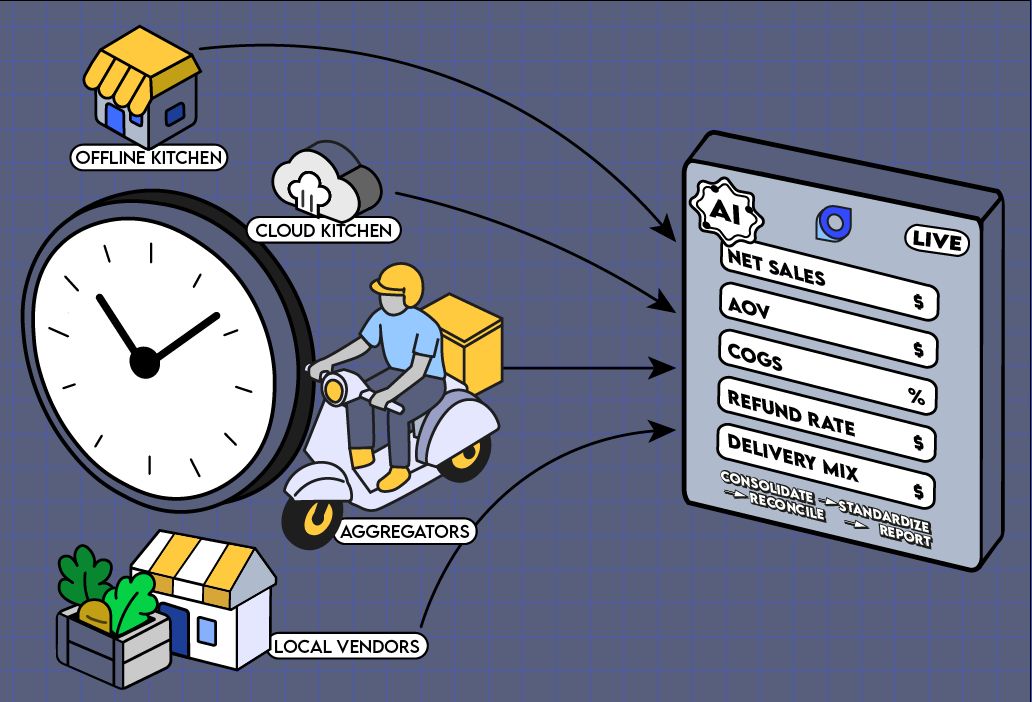Today, teams use finance observability templates to track and analyze the organization’s financial performance. These templates help finance leaders visualize the numbers in a meaningful way.
Finance observability templates integrate disparate financial, operational, and accounting data, reducing costs and improving profitability. This article shares some common examples of finance observability templates. It also gives you pellets on the capabilities of finance observability templates. To begin, it explores:
- What is a finance observability template?
- Primary capabilities of finance observability templates
- Challenges with finance observability templating
- 7 Examples of finance observability templates
- Takeaways
- FAQs
Let’s run through them real quick.
What is a finance observability template?
A finance observability template is a data visualization tool that helps CFOs, their teams, and business partners get real-time run down on financial and operational metrics. It visualizes financial data and helps teams understand the big picture.
These BI tools capture, track, and report key performance indicators (KPIs). Also, they can be customized to meet specific business needs.
Primary capabilities of finance observability templates
Sound finance observability templates help with decision-making, reducing customer acquisition costs, and closing sales. It slashes the time to accrue essential insights for financial and accounting professionals.
With finance observability templates, you could slice & dice, drill down, and share by permission. Other noteworthy benefits include:
- KPI tracking
- Trend identification
- Forecasting
- Collaboration
- Automated alerts
Challenges with finance observability templating
When you design and build finance observability templates, you end up with an inevitable problem. As different teams require different data and insights, unifying information is hard-bitten.
And if your template is not pulling real-time financial numbers, relying on it to make decisions pushes you into a burrow. Moreover, many templates still present numbers without going deeper and revealing the story ingrained in them.
How does Bluecopa simplify finance observability templating?
Bluecopa is an intuitive platform that tackles the above challenges and helps you easily create and manage finance observability templates. It comes with out-of-box metrics that help you stay on top of your company’s financial performance. You can also build custom metrics seamlessly.
Further, it collates data from multiple sources and condenses them into interactive charts and tables. At any time, you can be informed of the complete financial picture. Some advantages of Bluecopa you would like to know -
- Serve as a canvas where your finance and other teams can collaborate
- Disseminate financial information to the right people at the right time
- Comprise ready-to-deploy finance observability templates
Curious? Head here to see Bluecopa in action.
7 Examples of finance observability templates
#1 CFO template
The CFO template provides a centralized and visualized way for financial executives to track and analyze critical financial data. By accessing real-time metrics, CFOs can quickly identify financial trends, issues, and opportunities, allowing them to respond proactively and steer the company toward financial success.
Metrics included in a CFO template typically include:
- Revenue Metrics: These metrics focus on income and sales performance, including total revenue, revenue growth rate, and revenue breakdown by product or segment.
- Profitability Metrics: Metrics that assess profitability, such as gross profit margin, operating profit margin, and net profit margin.
- Cash Flow Metrics: These metrics provide insights into the cash inflows and outflows, including operating cash flow, investing cash flow, financing cash flow, and overall cash balance.
- Financial Ratios: Key financial ratios that help evaluate the financial health, including current ratio, quick ratio, debt-to-equity ratio, and return on equity (ROE).
- Budget vs. Actuals: A comparison of budgeted financial figures with actual performance, highlighting variances and deviations from the financial plan.
- Expense Metrics: Metrics related to expenses, such as cost of goods sold (COGS), operating expenses, and research and development (R&D) costs.
- Accounts Receivable and Payable: Metrics related to the accounts receivable turnover and average collection period, as well as accounts payable turnover and average payment period.
- Working Capital Metrics: These metrics focus on working capital management, including working capital ratio and days sales outstanding (DSO).
- Capital Expenditure (Capex) Metrics: Metrics related to investments in long-term assets, such as capital expenditure as a percentage of revenue or return on investment (ROI) for specific projects.
- Debt Metrics: Metrics related to debt, including total debt, debt-to-EBITDA ratio, and debt service coverage ratio.
- Risk Metrics: Metrics that assess financial risk exposure, such as market risk, credit risk, and liquidity risk.
- Forecasting and Projections: Information on financial forecasts and projections, helping the CFO plan for the future and make strategic decisions.
Other metrics you could usually witness in a CFO template include CAC, magic number, rule of 40, CLV, revenue retention, and recurring revenue.
#2 Executive template
Often used by C-suite members, investors, and board members, these templates provide a concise snapshot of business performance. They allow them to make data-driven decisions and monitor progress toward strategic goals.
- ARR (Annual Recurring Revenue): The yearly value of predictable and recurring revenue generated from customer subscriptions or contracts.
- Cash Balance: The total amount of money available in the business’s bank accounts at a specific period.
- Customer Count: The total number of customers or clients the company serves.
- ARR Changes: The percentage difference between the previous and current value of ARR, indicating growth or contraction.
- Expenses by Account Category: Categorization and breakdown of expenditure into specific account groups for financial analysis and tracking.
- Top 10 Vendors: The ten vendors or suppliers with the highest transaction volumes or spending in a given period.
- Net Burn: The rate at which a company spends its available cash after accounting for revenue and expenses.
- Headcount Composition: The distribution of employees across different departments, roles, or job categories within the organization.
- Liquidity: The ease with which an organization can convert its assets into cash to meet short-term obligations and financial needs.
#3 Financial performance template
A financial performance template is a visual tool presenting financial metrics and indicators clearly and concisely, enabling teams to monitor, analyze, and make informed decisions about a company’s financial health.
Here are some metrics -
- Cash Flow: Movement of money into and out of the business, indicating liquidity.
- Accounts Receivable Turnover: How efficiently a company collects payments from customers.
- Accounts Payable Turnover: How efficiently a company pays its suppliers.
- Current Ratio: Ratio of current assets to current liabilities, indicating short-term liquidity.
- Debt-to-Equity Ratio: Proportion of debt relative to equity, assessing financial leverage.
- Return on Assets (ROA): Profitability relative to total assets invested.
- Return on Equity (ROE): Profitability relative to shareholders' equity.
- Earnings Per Share (EPS): Profit attributed to each outstanding share of stock.
- Working Capital: Current assets minus current liabilities, measuring short-term operational liquidity.
- Inventory Turnover: How quickly inventory is sold and replenished.
#4 Forecast vs. Actual financial template
The forecast vs. actual financial template compares projected or forecasted financial data with actual financial performance. It allows stakeholders to analyze how well the business’s financial projections align with the outcomes. Also, it helps teams identify areas of strength or weakness and make informed decisions based on the analysis.
Metrics commonly found in a forecast vs. actual financial template include:
- Revenue Forecast vs. Actual: A comparison of the forecasted revenue with the actual revenue generated during a specific period.
- Expense Forecast vs. Actual: A comparison of forecasted expenses with the actual expenses incurred, typically categorized by different cost elements.
- Gross Profit Margin Forecast vs. Actual: A comparison of the projected gross profit margin with the actual gross profit margin, indicating the profitability of core business operations.
- Net Profit Forecast vs. Actual: A comparison of the forecasted net profit with the actual net profit, showing the overall profitability after considering all expenses.
- Cash Flow Forecast vs. Actual: A comparison of projected cash inflows and outflows with the actual cash flow during a given period.
- Budget Variance: The variance between the budgeted amounts and the actual financial results for various metrics, indicating areas where targets were met or missed.
- Customer Acquisition and Retention: A comparison of forecasted and actual customer acquisition and customer retention rates.
- Sales Forecast vs. Actual: A comparison of the forecasted sales with the actual sales achieved during the period.
- Inventory Forecast vs. Actual: A comparison of projected inventory levels with the actual inventory levels at hand.
- Debt Repayment Forecast vs. Actual: A comparison of projected debt repayment amounts with the actual debt payments made during the period.
- Profitability Ratios: Metrics like Return on Equity (ROE), Return on Investment (ROI), and Return on Assets (ROA) for forecasted and actual values.
- Forecast Accuracy: A metric that assesses the accuracy of past forecasts compared to actual results, providing insights into the reliability of the forecasting process.
#5 Cash flow template
A cash flow template is a financial management tool that represents the cash flow data of the business. It allows teams to monitor and analyze their cash inflows and outflows in real time or over specific periods. It lays a strong foundation for forecasting how strategic plans impact cash flow.
Metrics included in a cashflow template typically include:
- Cash Inflows: Includes metrics related to the sources of cash entering the business, such as sales revenue, loans, investments, or other income streams.
- Cash Outflows: This includes metrics related to cash leaving the business, such as expenses, salaries, loan repayments, taxes, and other operational costs.
- Net Cash Flow: The difference between total cash inflows and total cash outflows, showing the overall cash flow situation during the selected period.
- Operating Cash Flow (OCF): Specifies the cash generated or consumed by the core operations. OCF is a crucial metric to assess the ability of the business to sustain its operations.
- Investing Cash Flow: The cash flow resulting from capital expenditures, investments in assets, or proceeds from the sale of assets.
- Financing Cash Flow: The cash flow associated with specific activities like obtaining or repaying capital, such as raising funds through issuing stock or taking on debt.
- Cash Conversion Cycle (CCC): The time it takes for a company to convert its investments in inventory and other resources into cash from sales.
- Cash Balance: The total cash available to the company at a specific period.
- Burn Rate: The rate at which a company spends its available cash, often used by startups to gauge how long they can operate before needing additional funding.
- Projected Cash Flow: Estimates future cash flow based on current trends and assumptions.
#6 Sales and marketing financial template
Sales and marketing financial templates are a specialized management tool that provides a comprehensive view of key financial metrics related to sales and marketing activities. It aims to help sales and marketing teams, as well as executives and stakeholders, monitor the financial performance of these crucial departments.
The template typically includes a range of sales and marketing-related financial metrics, such as:
- Sales Revenue: The total revenue generated from sales activities, which can be further broken down by product, service, or region.
- Customer Acquisition Cost (CAC): The average cost incurred to acquire a new customer, calculated by dividing total sales and marketing expenses by the number of new customers gained.
- Customer Lifetime Value (CLV): The projected total revenue a customer is expected to generate throughout their relationship with the company, helping assess the long-term value of customers acquired.
- Marketing ROI (Return on Investment): The ratio of marketing revenue to marketing expenses, indicating the effectiveness of marketing efforts in generating revenue.
- Sales Growth Rate: The rate at which sales revenue increases or decreases over a specific period.
- Sales Pipeline Metrics: Information on the number of leads, opportunities, and sales stages in the sales pipeline, helping assess the health of the sales funnel.
- Marketing Campaign Performance: Metrics related to individual marketing campaigns, such as conversion rates, click-through rates (CTR), and cost per lead.
- Marketing Channel Performance: The effectiveness of different marketing channels, such as social media, email marketing, and paid advertising, in terms of generating leads and sales.
- Marketing and Sales Expenses: Breakdown of expenses incurred in marketing and sales activities, providing insights into cost management.
- Customer Retention Rate: The percentage of customers retained over a specific period, indicating customer loyalty and satisfaction.
- Sales and Marketing Budget vs. Actuals: A comparison of the budgeted expenses with the actual spending for sales and marketing initiatives.
- Lead-to-Customer Conversion Rate: The percentage of leads that convert into paying customers, indicating the efficiency of the sales process.
#7 Pipeline analysis template
This helps sales teams identify areas for improvement, optimize the sales process, and prioritize efforts to focus on opportunities with the highest potential for success. It visually represents the sales pipeline, enabling stakeholders to make data-driven decisions, forecast future revenue, and drive overall sales performance.
The pipeline analysis template comprises metrics like -
- Pipeline: The total value of all potential sales opportunities that are being pursued by the sales team.
- Weighted Pipeline: The total value of potential sales opportunities adjusted by the probability of closing, providing a more accurate representation of expected revenue.
- Cumulative Pipeline: The sum of all values of potential sales opportunities over a specified period, showing the overall growth of the pipeline.
- Top 10 Open Deals in Pipeline: The ten most valuable and active sales opportunities currently in the pipeline.
- Pipeline List: A detailed listing of all potential sales opportunities in the pipeline, including relevant information about each.
- Closed-Won and Closed-Lost Lists: Separate lists that track and document all deals successfully closed (won) and those that did not materialize (lost).
- Bookings: The total value of sales deals that had successfully closed and accepted, leading to an official commitment to purchase.
- Stale Pipeline List: A list of potential sales opportunities that have remained inactive or unattended for an extended period, requiring follow-up action to move them forward.
Takeaways
Finance observability templates combine all financial data and present it in an easy-to-understand manner. They can be customized to meet business needs and help teams collaborate effectively.
Investing in finance observability templates improves financial planning and leads to sustainable growth. So, if you want real-time insights and data-driven decisions, finance observability templates are the way to go! Speak to us if you want to gain visibility with Bluecopa templates.
FAQs
1. Why should you invest in finance observability templates?
Investing in finance observability templates offers real-time insights, data-driven decision-making, enhanced financial management, improved budgeting, and better communication with stakeholders, leading to streamlined analysis, strategic planning, and sustainable growth.
2. What are some components that finance observability templates must include?
A comprehensive finance observability template must include pivotal metrics (revenue, expenses, profit margins, cash flow), trend analysis, budget vs. actuals, KPIs, data drill-down, forecasting, real-time updates, and a user-friendly interface for effective financial monitoring and decision-making.
3. How do you build a rich finance observability template?
To create the best finance observability template, you must determine its purpose. Once you know what you want to achieve with your template, you can decide which metrics to include. Also, building finance observability templates can be time-consuming. However, Bluecopa finance observability templates are a more collaborative alternative to traditional finance templates that can be created much faster.




